Animal Feeding Operations (AFOs) - Manure Nutrient Management Technologies
The Nutrient Recycling Challenge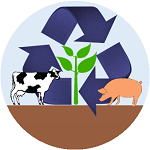
EPA has partnered with pork and dairy producers, the U.S. Department of Agriculture (USDA), and environmental and scientific experts to launch the Nutrient Recycling Challenge—a competition to develop affordable technologies that recycle nutrients from livestock manure. Every year, livestock producers manage over one billion tons of manure, which contains valuable nutrients—nitrogen and phosphorus—that plants need to grow. Challenge entrants will develop technologies that extract nutrients from manure to generate products with environmental and economic benefits that farmers can use or sell.
The competition has four phases in which innovators can turn their concepts into designs, and eventually, into working technologies to be piloted on livestock farms. In Phase I, which ended January 15, 2016, EPA received 75 concept papers from around the world, and selected 34 submissions to continue on to Phase II of the challenge. EPA awarded a total of $30,000 in cash prizes to the top ten submissions (four "Winners" and six "Honorable Mentions").
Phase II
Phase II of the Nutrient Recycling Challenge is a non-competitive incubation program to support innovators as they develop Technology Designs based on their submitted concepts. Phase II began in October 2016 and is only open to the 34 teams selected in Phase I. EPA and its partners are supporting challenge participants with informational webinars and workshops, opportunities to learn about livestock operations, mentorship, and feedback that can maximize their ability to develop designs for effective and affordable technologies.
Innovators will complete their designs by March 2017 in preparation for Phase III of the challenge, which is expected to be a prize competition for building prototypes based on innovators’ designs. The plan for the fourth and final phase of the challenge is to conduct demonstration pilots of nutrient recovery technologies on real-life farms.
Alternative Uses of Manure
Throughout history, people who raise livestock and poultry have used manure as a fertilizer, soil amendment, energy source, even construction material. Manure contains many useful, recyclable components, including nutrients, organic matter, solids, energy, and fiber. With today’s technology, manure can be used more efficiently and in more ways than ever, which should mitigate many of the environmental impacts that result when manure is treated as a waste.
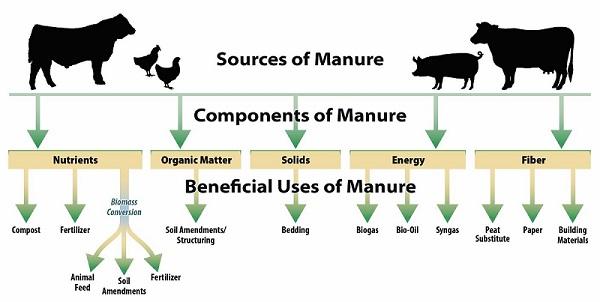
Nutrients
Farmers, gardeners, landscapers, and others commonly use livestock manure as a fertilizer to provide nutrients needed for crop production. Manure nutrients have real value as fertilizer. Manure’s fertilizer value will increase as the price of commercial fertilizers increase.
Like commercial fertilizer, manure must be managed properly to avoid environmental impacts. Manure has fertilizer value in its raw form; however, processing manure through digestion, composting, or other means can yield materials that are more portable and whose nutrients are more available to plants, more balanced to crop needs, or less prone to environmental losses.
Fresh Manure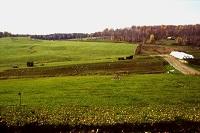
Using fresh manure as a fertilizer to raise crops that will be fed back to the livestock, either directly or as a by-product of further processing, is an excellent way to recycle nutrients. Ideally, fresh manure would be used on the farm where the manure is generated or on a neighboring farm, because fresh manure is expensive to haul even short distances.
Livestock manure is commonly land-applied as a semi-solid or liquid. Farmers can incorporate manure into the soil or inject it under the soil surface to reduce the risk of runoff losses and odor problems. Sometimes manure solids are separated from the liquid. Following liquid/solid manure separation, the remaining manure liquids still contain about half of the original nutrients. The solids can be used for bedding or for other uses and the liquids can be land applied to both water and fertilize crops.
Farmers are the most common users of fresh manure for fertilizer, but home gardeners and landscapers also sometimes fertilize with fresh manure.
Compost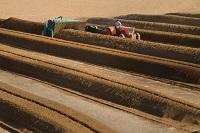
Composting livestock manure reduces odors, kills disease-causing agents (pathogens), reduces bulk, and stabilizes the manure for easier handling. A properly constructed and managed manure composting operation can also process mortalities Exit(dead animals) from livestock operations. In some parts of the country, composting operations must be intensively managed to guarantee pathogen-free compost that meets requirements of both health regulations and public perception.
Compost can be applied more evenly and with better control than manure. The nitrogen in compost is not as readily available to plants as the nitrogen in fresh manure, but the availability of phosphorus, potassium and other nutrients from compost is similar to, or higher than, the availability of those nutrients from fresh manure.
Farmers and ranchers can use composted manure at their own operations as fertilizer or bedding. Sales of compost can remove excess nutrients from farms and ranches that cannot use all of their manure nutrients for their own needs.
Compost is less expensive to transport than fresh manure due to its lower moisture content, and more profitable to transport because of its higher market value. This means that compost has more potential for use in areas farther from the farm. Manure compost can be used for many purposes in non-agricultural areas, including site restoration, erosion control, soil remediation, and wetland restoration.
- North Dakota State University Extension’s Composting Animal Manures (PDF)(8 pp, 358 K, About PDF) Exit
- Kansas Department of Health and Environment’s Composting at Livestock Facilities (PDF)(5 pp, 387 K, About PDF) Exit
Other Manure Products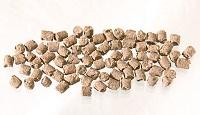
Pelletizing compacts fresh manure at high temperature and pressure to convert it into a dry finished product. Pellets are useful as a soil amendment or fertilizer. Because the pellets take up a smaller volume, they can be more easily stored and transported than manure. In some cases, processing can result in a product with a consistent and predictable nutrient content, making it more convenient for crop production and other uses. The pelletizing process is mainly used for poultry litter but could be applied to separated solids from other manures.
Nutrient extraction technologies, or manure nutrient recovery technologies, can remove nutrients from manure for fertilizer products. Nutrient extraction removes elemental nutrients from raw manure, separated liquids, or residuals of anaerobic digestion by chemical precipitation or coagulation. Examples of fertilizer products that can be generated with nutrient extraction systems are ammonium sulfate, calcium phosphate, and magnesium ammonium sulfate (struvite) crystals.
Biomass Conversion
Bioconversion involves growing organisms on manure or manure nutrients and then harvesting them to use as components of animal feed, fertilizer, or soil amendments.
Algae grown on nutrients from dairy wastewater can be harvested to produce a product used in plant fertilizers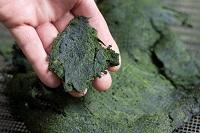 and high-protein animal feed supplements. Black soldier fly larvae eat manure, killing disease-causing agents (pathogens) and transferring the manure nutrients to their bodies. The nutrient-rich larvae are a value-added product that can be exported off the farm. High protein feeds made with products like these can be worth up to $500 per ton. The manure left over after the larvae are harvested is useful as a soil amendment or fertilizer similar to compost.
and high-protein animal feed supplements. Black soldier fly larvae eat manure, killing disease-causing agents (pathogens) and transferring the manure nutrients to their bodies. The nutrient-rich larvae are a value-added product that can be exported off the farm. High protein feeds made with products like these can be worth up to $500 per ton. The manure left over after the larvae are harvested is useful as a soil amendment or fertilizer similar to compost.
Vermicomposting uses worms to digest manure, creating pathogen-free, nutrient-rich products that can be sold and 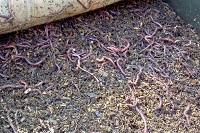 exported off the farm. Worms produce nutrient-rich castings. The castings, along with the manure used to grow the worms, are useful as a fertilizer or soil amendment. This vermicompost is said to contain more available plant nutrients than conventional compost. In addition to the revenue from selling the vermicompost, the worms can be sold as fishing bait or processed for supplemental feed for poultry or fish operations.
exported off the farm. Worms produce nutrient-rich castings. The castings, along with the manure used to grow the worms, are useful as a fertilizer or soil amendment. This vermicompost is said to contain more available plant nutrients than conventional compost. In addition to the revenue from selling the vermicompost, the worms can be sold as fishing bait or processed for supplemental feed for poultry or fish operations.
Organic Matter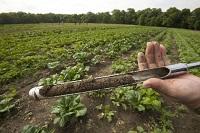
Farmers, gardeners, and others use livestock manure as a soil amendment to improve soil quality. In addition to providing nutrients for plant growth, applying fresh or composted livestock manure to cropland improves soil organic matter and tilth (the physical conditions that make a soil suitable for growing crops). Applying livestock manure to cropland increases the amount of organic matter in the soil which improves the soil structure and can increase the soil’s ability to hold water.
Increasing soil organic matter also helps keep carbon in the soil (“carbon sequestration”) and out of the atmosphere where it can form the greenhouse gas carbon dioxide. Manure provides these benefits when it is applied in raw form or when solids are applied after solid-liquid separation, pelletizing, digestion, or composting.
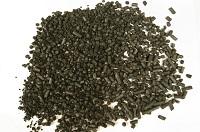 Biochar can enhance soils and store carbon. When used as a soil amendment, biochar provides nutrients in a stable form that is available to plants, reducing the risk of runoff losses or leaching to groundwater. Biochar also improves soil tilth, porosity, water holding capacity, cation exchange capacity (CEC), soil biology, and fertilizer efficiency. Biochar is a stable form of soil organic carbon, sequestering carbon for potentially thousands of years.
Biochar can enhance soils and store carbon. When used as a soil amendment, biochar provides nutrients in a stable form that is available to plants, reducing the risk of runoff losses or leaching to groundwater. Biochar also improves soil tilth, porosity, water holding capacity, cation exchange capacity (CEC), soil biology, and fertilizer efficiency. Biochar is a stable form of soil organic carbon, sequestering carbon for potentially thousands of years.- U.S.-Focused Biochar Report: Assessment of Biochar's Benefits for the United States of America (PDF)(84 pp, 1.5 MB, About PDF) Exit - Report by the Center for Energy and Environmental Security and the United States Biochar Initiative.
Solids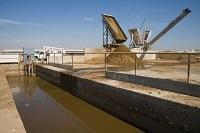
Some dairy farms use sawdust, wood shavings, straw, sand, or other purchased materials as animal bedding. Bedding can be expensive—on the order of $40 to $50/cow/year. In recent decades, traditional bedding materials like sawdust or sand have become more expensive. Solid material can be recovered from manure (through solid-liquid separation, composting, or anaerobic digestion) and used as bedding, replacing materials purchased from off the farm.
- Use of Dried Manure Solids as Bedding for Dairy Cows (PDF) (9 pp, 487 K, About PDF) Exit - Report by the Cornell Waste Management Institute.
Energy
- Manure Use for Fertilizer and for Energy: Report to Congress - USDA's report states that use of manure for energy production would not detract from the use of manure for fertilizer because the processes used to produce energy leave the manure nutrients as residues to be used elsewhere.
Biogas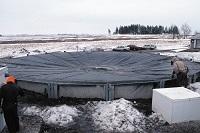
Biogas recovered from anaerobic digesters is useful for generating heat or electricity to use on the farm or sell to the local power grid. Biogas production usually uses dairy or swine manure because of their relatively high methane producing potential. However, some digesters in the U.S. use beef manure or poultry litter as feedstocks.
Gas from anaerobic digestion is about 60 to 80 percent methane and has a heating value of 600 – 800 BTU/ft3. (As a comparison, natural gas generally contains more than 85 percent methane and has a heating value of about 950 – 1050 BTU/ft3). Most equipment that uses natural gas, butane, or propane as fuel can be modified to use biogas. This includes boilers, space heaters, and electrical generators.
Because digesters capture methane and other air pollutants, they reduce harmful air emissions from manure and provide superior odor control. Using biogas from digesters also offsets fuel consumption and emissions from non-renewable fossil fuels.
- EPA's AgSTAR program has more information about anaerobic digestion of manure for energy.
Bio-oil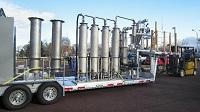
Liquid bio-oil fuels can be produced from manure by thermochemical processes like pyrolysis and gasification. Bioconversion, such as growing algae with manure nutrients, is another process that can produce bio-oil.
Bio-oils are physically different from petroleum-based fuel oil. For example, bio-oils have a lower energy content per gallon and higher acidity than petroleum-based fuel oil. However, tests indicate that bio-oil could be used for applications such as heating or generating electricity.
Commercial experience with biodiesel has been very promising. Biodiesel performs as well as petroleum diesel, while reducing air emissions of particulate matter, carbon monoxide, hydrocarbons and sulfur oxides.
- Pyrolyss Technology: Environmentally friendly solution to nutrient management in the Chesapeake Bay (PDF) (35 pp, 2.9 MB, About PDF) Exit - Virginia Tech reports promising results from its experimental mobile pyrolysis unit for poultry litter treatment.
- California’s Alternative and Renewable Fuel and Vehicle Technology Program Exit projects that commercial-scale biodiesel production from air-dried dairy manure could result in up to 6.8 million gallons of renewable diesel annually, 30 to 50 full-time jobs, and annual greenhouse gas reductions of 851,050 tons equivalent carbon dioxide [CO2e] of methane and 720,666 tons CO2e of nitrogen oxides.
Syngas
Gasification can covert manure (at present mainly poultry litter) into a synthetic gas fuel composed of a mixture of water vapor, tars, hydrogen gas, carbon monoxide, carbon dioxide, nitrogen gas, and hydrocarbon gases. Some of the gas condenses to form a combustible bio-oil. The remaining gas can fuel a variety of power systems including reciprocating engines, gas turbines, and fuel cells.
Fiber
It is possible to produce specialty value-added products from livestock manure for marketing to consumers based on the fiber content of the manure. For the most part, the examples given below are either experimental or done on a boutique scale. Most involve extracting and using the solid fiber from manure.
- Peat moss substitute. Fiber recovered from anaerobic digestion of dairy manure is useful as a plant growth medium. Plant growth trials have shown that, when properly processed, the fiber performs like peat moss for growing container plants.

- Novelty Fiber products. Farmers and other innovators are finding creative ways to make value-added products from fiber recovered from manure.
- Nursery pots, manure-fiber based seed starter pots, made with biodegradable composted cow manure.
- Sculptures made with composted manure and marketed as fertilizing garden art.
- Paper made from processed manure from a variety of animals, including elephants and cows. The dried manure is rinsed in water, leaving the undigested fiber, which is boiled and mixed with other natural fibers to manufacture a variety of paper products.
- Building materials. Recovered manure fiber has been included in fiberboard for building construction.
Implementation Funding
The programs below provide operators of AFOs, as well as other farmers and ranchers, businesses, and other organizations, with financial and technical assistance information. These resources promote implementation of conservation practices and other management changes that help protect water quality and other natural resources.
- 319 Nonpoint Source Grants
- Agricultural Management Assistance Program (AMA)
- Agriculture and Food Research Initiative (AFRI)
- Agriculture Conservation Easement Program (ACEP)
- AgSTAR Program
- Biomass Crop Assistance Program (BCAP)
- Biomass Research and Development Initiative (BRDI)
- Business and Industry (B&I) Guaranteed Loans Program
- Clean Water State Revolving Fund
- Conservation Innovation Grants (CIG)
- Conservation Loan Program (CLP)
- Conservation Reserve Program (CRP)
- Conservation Reserve Program - Transition Incentives Program (CRP-TIP)
- Conservation Stewardship Program (CSP)
- Conservation Technical Assistance Program (CTA)
- Environmental Quality Incentives Program (EQIP)
- Farm Ownership Loans Direct and Guaranteed
- Five Star and Urban Waters Restoration Grant
- National Integrated Water Quality Program (NIWQP)
- Outreach for Socially Disadvantaged and Veteran Farmers and Ranchers (Section 2501) Program
- Regional Agricultural IPM Grants
- Regional Conservation Partnership Program (RCPP)
- Rural Energy for America Program (REAP) Energy Audit & Renewable Energy Development Assistance (REDA) Grants
- REAP Renewable Energy Systems and Energy Efficiency Improvement Loans and Grants
- Small Business Innovation Research (SBIR)
- Source Reduction Assistance Grant Program
- Sustainable Agriculture Research & Education Grants (SARE)
- Value-Added Producer Grants (VAPG)
- Water Bank Program (WBP)
- WaterSMART Grants
- Wetlands Program Development Grants (WPDG)
USDA Natural Resource Conservation Service (NRCS)
Environmental Quality Incentives Program (EQIP)
EQIP is a voluntary program that provides financial and technical assistance to implement conservation practices on cropland, rangeland, pastureland, non-industrial private forestland and other farm or ranch lands.
Who is eligible?
- Farmers
- Tribes
- Private landowners
- Ranchers
- State/Territorial agencies
- Tribal agencies
What projects are eligible?
- Conservation practices that address natural resource concerns and improve soil, water, plant, animal, air, and related resources
- Development of conservation plans required to support EQIP projects
- Support from Technical Service Providers (TSP) to develop Conservation Activity Plans (CAP) to address certain land use activities or specific resource needs
EQIP Air Quality Initiative
The EQIP Air Quality Initiative provides financial assistance to implement conservation practices to address significant air quality resource concerns for high priority geographic locations on cropland, rangeland, pastureland, private non-industrial forestland, and other farm or ranch lands.
Who is eligible?
- Persons or entities who own land in agricultural or forest production
- Persons or entities engaged in livestock, agricultural, or forest production
What projects are eligible?
- Establishment of cover crops
- Planting windbreaks
- Implementation of nutrient management practices
- Application of other conservation measures that mitigate and prevent air quality problems
EQIP On-Farm Energy Initiative
The EQIP National On-Farm Energy Initiative provides financial assistance for site-specific energy analysis of eligible farmsteads and irrigation systems on cropland, rangeland, and pastureland.
Who is eligible?
- Individuals
- Legal entities
- Indian Tribes
- Joint operations engaged in agricultural production
What projects are eligible?
Financial assistance is available for an Agricultural Energy Management Plan (AgEMP), which clearly shows:
- Itemized energy use by individual systems to establish a baseline for electricity and other fuel improvements
- Recommendations for equipment improvements and upgrades
- Amount of potential energy reductions and financial savings for each recommendation
- Cost estimates of potential improvements
- Length of expected payback for energy efficiency upgrades
With a completed AgEMP or other qualifying energy audit, eligible producers can apply for EQIP assistance for the purchase and installation of various improvements.
EQIP Organic Initiative
The EQIP Organic Initiative provides financial assistance to organic producers to implement conservation practices in addressing resource concerns on cropland, rangeland, pastureland, and other farm or ranch lands.
Who is eligible?
- Farmers
- Ranchers
What projects are eligible?
- Development of a conservation plan
- Establishment of buffer zones
- Planning and installation of pollinator habitat
- Improvement of soil quality and organic matter while minimizing erosion
- Development of a grazing plan and supportive livestock practices
- Improvement of irrigation efficiency
- Enhancement of cropping rotations and nutrient management
Seasonal High Tunnel Initiative System for Crops
The Seasonal High Tunnel System for Crops is a conservation practice that helps agricultural producers extend the growing season for high value crops in an environmentally safe manner on existing managed cropland and land that has an active crop production history.
Who is eligible?
- Individuals
- Legal entities
- Indian Tribes
- Joint operations engaged in agricultural production
- Organic producers who grow agricultural commodities on eligible land and have natural resource concerns which may be addressed by a seasonal high tunnel
What projects are eligible?
The initiative supports implementation of seasonal high tunnel systems for crops.
The following supporting practices are also available to producers, as applicable to their state, to help ensure that the resource concerns are addressed while implementing and managing the seasonal high tunnel:
- Critical area planting
- Diversion
- Grassed waterway
- Irrigation reservoir
- Irrigation system, microirrigation
- Subsurface drain
- Surface drainage, Ffeld ditch
- Underground outlet
National Water Quality Initiative
The National Water Quality Initiative (NWQI) offers financial and technical assistance to eligible producers interested to implement conservation systems to improve water quality and aquatic habitats in priority watersheds with impaired streams. Priority watersheds are identified for each funding cycle. Assistance is provided through EQIP.
Who is eligible?
- Farmers
- Ranchers
What projects are eligible?
Installation of conservation systems to reduce nitrogen, phosphorous, sediment, and pathogen contributions from agricultural land; may include practices such as:
- Nutrient management
- Cover crops
- Conservation cropping systems
- Filter strips
- Terraces
- Edge-of-field water quality monitoring.
Agricultural Management Assistance Program (AMA)
AMA provides financial and technical assistance to agricultural producers to voluntarily incorporate conservation on agricultural land, nonindustrial private forest land, or other lands that may benefit from adding conservation practices.
Who is eligible?
- Farmers
- Ranchers
- Tribes
- Individuals
- Cooperatives
- AMA is available in Connecticut, Delaware, Hawaii, Maine, Maryland, Massachusetts, Nevada, New Hampshire, New Jersey, New York, Pennsylvania, Rhode Island, Utah, Vermont, West Virginia, and Wyoming.
What projects are eligible?
- Construction or improvement of water management or irrigation structures
- Tree plantings for windbreaks or water quality improvement
- Risk mitigation through production diversification or implementation of conservation practices including soil erosion control, integrated pest management or transition to organic farming in order to improve water quality and mitigate risk
Conservation Innovation Grants (CIG)
CIG is a voluntary program to stimulate the development and adoption of innovative conservation approaches and technologies for conservation on agricultural lands.
Who is eligible?
- State, local, and tribal governments
- Nongovernmental organizations
- Individuals
What projects are eligible?
- Innovative on-the ground conservation projects, including pilot projects and field demonstrations
- Technologies and approaches commonly used in the geographic area covered by the application, and which are eligible for EQIP funding, are NOT eligible for funding through CIG.
Conservation Stewardship Program (CSP)
CSP helps agricultural producers maintain and improve their existing conservation systems and adopt additional conservation activities to address priority resources concerns on cropland, pasture, and rangeland.
Who is eligible?
- Farmers
- Ranchers
- Producers
What projects are eligible?
- Projects to improve soil, water, and air quality
- Projects to increase biodiversity and wildlife and pollinator habitat
- Projects to sequester carbon and reduce greenhouse gases to mitigate climate change
- Projects to help to conserve water and energy
Regional Conservation Partnership Program (RCPP)
RCPP funds can be used by conservation partner organizations to provide assistance directly to producers to implement conservation activities on their farms.
Who is eligible?
Eligible partners include:
- Agricultural or silvicultural producer associations
- Farmer cooperatives or other groups of producers
- State or local governments
- American Indian tribes
- Municipal water treatment entities
- Water and irrigation districts
- Conservation-driven nongovernmental organizations
- Institutions of higher education
Eligible participants that may enter into conservation program contracts or easement agreements under the framework of a partnership agreement include:
- Eligible producers and landowners of agricultural land
- Eligible landowners of non-industrial private forestland
What projects are eligible?
- Nutrient pollution reduction in impaired watersheds
- Cover crop adoption to improve soil health and reduce runoff
- Market development for carbon sequestration credit trading
Funding also can be directed to partners for a variety of technical assistance activities, including:
- Resource assessment
- Conservation practice survey and design
- Conservation planning
- Resource monitoring
Agriculture Conservation Easement Program (ACEP)
ACEP provides financial and technical assistance to help conserve agricultural lands and wetlands and their related benefits on cropland, rangeland, grassland, pastureland, and nonindustrial private forest land.
Who is eligible?
Agricultural land easement
- Non-profit organizations
- State and local agencies
- Indian tribes
Wetland land easement
Landowners
What projects are eligible?
Agricultural land easement
The proposed agricultural land easement must:
- Be subject to a pending offer for purchase of an agricultural land easement from an eligible entity;
- Have prime, unique, or productive soil, and meet one of the following criteria:
- Contain historical or archaeological resources; or
- Protect grazing uses by restoring and conserving land; or
- Further a State or local policy consistent with the purposes of the program
AND
- Meet one of the following criteria:
- Be cropland, rangeland, grassland; or
- Be land that contains forbs or shrub land for which grazing is the predominant use; or
- Be located in an area that has been historically dominated by grass-land, forbs, or shrubs and could provide habitat for animal or plant populations of significant ecological value; or
- Be pastureland or nonindustrial private forestland that contributes to the economic viability of an offered parcel or serves as a buffer to protect such land from development.
Wetland land easement
The proposed wetland land easement must be:
- Farmed or converted wetlands, together with adjacent land that is functionally dependent on that land; or
- Flooded cropland or grassland that was used for agricultural production prior to flooding from the natural overflow of either a closed basin lake or a pothole; or
- Farmed wetlands and adjoining lands that are enrolled in the CRP, have high wetland functions and values, and would return to production after they leave CRP; or
- Riparian areas that link protected wetlands; or
- Other wetlands that would not otherwise be eligible, if USDA determines that the inclusion of such wetlands would add to the functional value of the easement.
Water Bank Program (WBP)
The WBP provides financial assistance to landowners through annual payments for conserving and protecting wetlands and adjacent lands from adverse land uses and activities, such as drainage, that would destroy the wetland characteristics of those lands. Geographic eligibility varies from year to year.
Who is eligible?
To be eligible to participate in the WBP, a person must:
- Be the landowner of eligible land for which enrollment is sought; or
- Have possession of the land by written lease over all designated acreage in the agreement.
What projects are eligible?
- Projects that conserve surface waters
- Projects that preserve and improve the Nation's wetlands
- Projects that increase migratory waterfowl habitat in nesting, breeding, and feeding areas in the U.S.
- Projects that secure environmental benefits for the Nation
- Financial assistance is not available for conservation practices through WBP
- Land enrolled in WBP may not be cropped
Conservation Technical Assistance (CTA) Program
The CTA program provides land users with proven conservation technology and the delivery system needed to achieve the benefits of a healthy and productive landscape.
Who is eligible?
- Individuals
- Groups
- Tribes
- Units of government
What projects are eligible?
- Development and implementation of resource management plans
- Providing assistance to agricultural producers to comply with the Highly Erodible Land (HEL) and Wetland (Swampbuster) Conservation Compliance Provisions of the l985 Food Security Act, as amended
- Providing assistance to decision-makers to comply with Federal, State, tribal, and local environmental regulations and related requirements, and to prepare them to become eligible to participate in other Federal, State, and local conservation programs
- Provide soils information and interpretation to aid sound decision making in the wise use and management of soil resources
- Collect, analyze, interpret, display, and disseminate information about the status, condition, and trend of soil, water, and related natural resources
- Assess the effects of conservation practices and systems on the condition of natural resources
Note: The CTA program does not include financial or cost-share assistance. Clients may develop conservation plans, which may serve as a springboard for those interested in participating in USDA financial assistance programs. CTA planning can also serve as a door to financial assistance and easement conservation programs provided by other Federal, State, and local programs.
USDA Rural Development
Rural Energy for America Program (REAP) Renewable Energy Systems and Energy Efficiency Improvement Loans and Grants
REAP renewable energy systems and energy efficiency improvement loans and grants provides guaranteed loan financing and grant funding to eligible participants to purchase or install renewable energy systems or make energy efficiency improvements.
Who is eligible?
- Agricultural producers in rural or non-rural areas
- Rural small businesses (not located in a city or town with a population of greater than 50,000 inhabitants or the urbanized area of that city or town)
What projects are eligible?
Funds may be used to purchase, install, and construct renewable energy systems, such as:
- Biomass (e.g., biodiesel and ethanol, anaerobic digesters, and solid fuels)
- Geothermal for electric generation or direct use
- Hydropower below 30 megawatts
- Hydrogen
- Small and large wind generation
- Small and large solar generation
- Ocean (tidal, current, thermal) generation
Funds may also be used to purchase, install and construct energy efficiency improvements, such as:
- High efficiency heating, ventilation, and air conditioning systems (HVAC)
- Insulation
- Lighting
- Cooling or refrigeration units
- Doors and windows
- Electric
- Solar or gravity pumps for sprinkler pivots
- Switching from a diesel to electric irrigation motor
- Replacement of energy-inefficient equipment
Rural Energy for America Program (REAP) Energy Audit & Renewable Energy Development Assistance (REDA) Grants
REDA grantees assist rural small businesses and agricultural producers by conducting and promoting energy audits, and providing renewable energy development assistance to increase the private sector supply of renewable energy and decrease the demand for energy through energy efficiency improvements.
Who is eligible?
- State and local governments
- Federally-recognized tribes
- Land grant institutions
- Rural electric cooperatives
- Public power entities
- An instrumentality of a state, tribal, or local government
- A Resource Conservation & Development Council (as defined in 16 USC §3451)
What projects are eligible?
- Energy audits
- Renewable energy technical assistance
- Renewable energy site assessments
Eligible project costs may include:
- Salaries directly related to the project.
- Travel expenses directly related to conducting energy audits or renewable energy development assistance.
- Office supplies.
- Administrative expenses, up to a maximum of 5% of the grant, which include but are not limited to utilities, office space, operation expenses of office and other project-related equipment.
Project funds may NOT be used for:
- Payment for construction-related activities.
- Purchase or lease of equipment.
- Payment of judgments or debt owed the government.
- Goods or services provided by a person or entity who has a conflict of interest.
- Costs incurred by preparing an application package.
- Funding political or lobbying activities.
Business and Industry (B&I) Guaranteed Loan Program
The B&I Guaranteed Loan Program bolsters the existing private credit structure through the guaranteeing of loans for rural businesses, allowing private lenders to extend more credit than they would typically be able to.
Who is eligible?
Lenders with legal authority, sufficient experience, and financial strength to operate a successful lending program may apply; these include:
- Federal or state chartered banks
- Savings and loans
- Farm credit banks
- Credit Unions
Eligible lenders may request guarantees for:
- Rural businesses (located in an area other than a city or town with a population of greater than 50,000 inhabitants and the urbanized area of that city or town. The borrower’s headquarters may be based in a larger city as long as the project is in an eligible rural area.)
- Cooperative organization, corporation, partnership, other legal entity organized or operated on a profit or nonprofit basis
- Indian tribe on a federal or state reservation
- Public body
- Individual
What projects are eligible?
- Business conversion, enlargement, repair, modernization, or development
- Purchase and development of land, easements, rights-of-way, buildings, or facilities
- Purchase of equipment, leasehold improvements, machinery, supplies, or inventory
- Debt refinancing when new jobs will be created and other conditions are met
- Business and industrial acquisitions when the loan will keep the business from closing and/or save or create jobs
Guaranteed loan funds MAY NOT be used for:
- Lines of credit
- Owner-occupied housing
- Golf courses
- Racetracks or gambling facilities
- Churches, church-controlled organizations, or charitable organizations
- Fraternal organizations
- Lending, investment, and insurance companies
- Projects involving more than $1 million and the relocation of 50 or more jobs
- Agricultural production, with certain exceptions
- Distribution or payment to an individual owner, partner, stockholder, or beneficiary of the borrower or a close relative of such an individual when such individual will retain any portion of the ownership of the borrower
Value-Added Producer Grants (VAPG)
The VAPG program helps agricultural producers enter into value-added activities related to the processing and/or marketing of bio-based, value-added products.
Who is eligible?
- Farmers
- Ranchers
- Loggers
- Fishermen
- Farmer or rancher cooperatives
- Majority-controlled producer-based business ventures
- Organizations presenting agricultural producers
What projects are eligible?
Grant and matching funds can be used for planning activities or for working capital expenses related to producing and marketing a value-added agricultural product.
- Feasibility studies
- Business plan development
- Processing costs
- Marketing and advertising expenses
- Some inventory and salary expenses
USDA Farm Service Agency (FSA)
Conservation Loan Program (CLP)
CLP provides access to credit for farmers to implement conservation measures on their land.
Who is eligible?
- Farmers
- Ranchers
- Sole proprietors
- Farmer cooperatives
- Private corporations
- Partnerships
- Limited liability companies
What projects are eligible?
Conservation practices included in an NRCS-approved conservation plan.
- Installation of conservation structures
- Establishment of forest cover
- Installation of water conservation measures
- Establishment or improvement of permanent pastures
- Transitioning to organic production
- Manure management, including manure digestion systems
- Adaptation of other emerging or existing conservation practices, techniques or technologies
- Conservation practices needed to comply with highly erodible land “compliance” requirements
- Conservation buffer practices such as grassed waterways, shelterbelts, windbreaks, riparian buffers and filter strips, and living snow fences
Farm Ownership Loans Direct and Guaranteed
Loan programs are designed to help family farmers obtain loans and loan guarantees through the extension of credit and supervisory assistance to become owner-operators of family farms; make efficient use of land, labor, and other resources; carry on sound and successful farming operations; and enable farm families to have a reasonable standard of living.
Who is eligible?
- Farmers
What projects are eligible?
- Purchase of farmland
- Building construction or repair
- Promote soil and water conservation
- Purchase of livestock, farm equipment, feed, seed, fuel, insurance or other operating expenses
- Minor improvements to buildings
- Costs associated with land and water development
- Refinance debts under certain conditions
Conservation Reserve Program (CRP)
CRP is a land conservation program in which enrolled farmers agree to remove environmentally sensitive land from agricultural production and plant species that will improve environmental health and quality in exchange for a yearly rental payment.
Who is eligible?
- Farmers
- Landowners
What projects are eligible?
- Planting native prairie and trees
- Establishing longer lasting meadows of native wildflowers
- Restoring farmable wetlands and development of nesting habitat in areas deemed as the most critical waterfowl areas
- Providing opportunities for local students to learn about conservation and natural resources
Conservation Reserve Program - Transition Incentives Program (CRP-TIP)
CRP-TIP assists with the transition of expiring CRP land from a retired or retiring owner or operator to an eligible farmer or rancher to return land to production for sustainable grazing or crop production.
Who is eligible?
- All eligible CRP landowners or operators
- Beginning farmers and ranchers
- Socially disadvantaged farmers and ranchers
- Veteran farmers and ranchers
What projects are eligible?
- Assistance to beginning farmers to help them compete with more established farmers and farmland investors in accessing CRP land
- Retention of conservation on the land by helping beginning farmers develop and implement a conservation plan
Biomass Crop Assistance Program (BCAP)
BCAP is part of the national strategy to reduce U.S. reliance on foreign oil, improve domestic energy security, and reduce carbon pollution, by developing more agricultural products made in rural America.
Who is eligible?
- Farmers
- Forest landowners
What projects are eligible?
BCAP funds assist with growing, maintaining, and harvesting biomass that can be used for energy or bio-based products. BCAP provides assistance in three ways:
- Establishment payments
- Maintenance payments (annual payments)
- Retrieval payments (matching payments) to collect existing biomass residues that are not economically retrievable
USDA National Institute of Food and Agriculture (NIFA)
Sustainable Agriculture Research & Education Grants (SARE)
SARE Exit is a competitive grants research program that focuses solely on sustainable agriculture.
Who is eligible?
- Researchers
- Agricultural educators
- Students
- Farmers and ranchers
What projects are eligible?
Eligibility requirements vary by region and grant category. Visit the appropriate regional site to learn more about SARE grant eligibility in your region:
Biomass Research and Development Initiative (BRDI)
BRDI is a financial assistance program that supports the development of a biomass-based industry in the United States.
Who is eligible?
- 1862 land-grant institutions
- 1890 land-grant institutions
- 1994 land-grant institutions
- Hispanic-serving institutions
- Nonprofits with 501(c)(3) IRS status other than institutions of higher education
- Private institutions of higher education
- Small business
- State controlled institutions of higher education
What projects are eligible?
BRDI technical topic areas are:
- Feedstock development
- Biofuels and bioproduct development
- Biofuels development analysis
National Integrated Water Quality Program (NIWQP)
NIWQP contributes to the improvement of the quality of surface water and groundwater resources through research, education, and extension activities.
Who is eligible?
- Colleges and universities
- 1994 land-grant institutions (tribal colleges)
- Hispanic-serving agricultural colleges and universities
What projects are eligible?
- Projects that work to solve water resource problems by advancing and disseminating the knowledge base available
- Projects that lead to science-based decision making and management practices
- Farm, landscape and watershed scale projects
- Projects that synthesize scientific understanding and accomplishments made through past NIFA-funded water projects
Integrated projects submitted under the NIWQP should include ALL three functions of agriculture knowledge (i.e., research, education, outreach/extension).
Agriculture and Food Research Initiative (AFRI)
AFRI funds research, education, and extension grants that address key problems of national, regional, and multi-state importance in sustaining all components of agriculture.
The following eligibility information is for applications submitted under the “renewable energy, natural resources, and environment” AFRI target area.
Who is eligible?
- State agricultural experiment stations
- Colleges and universities
- University research foundations
- Other research institutions and organizations
- Federal agencies
- National laboratories
- Private organizations or corporations
- Individuals
- Any group consisting of two or more of the aforementioned entities
What projects are eligible?
Applications submitted must address one of the following two program area priorities:
Nitrogen and phosphorus cycling:
- Management/conservation practices and/or processes, including multi-cropping, across soil-air-water interfaces
- Foundational research that supports decision-support tools for assessment of ecosystem services including: control technologies to mitigate nitrogen and phosphorus movement or impairment in plant and/or animal production systems; or process-based models to assess nitrogen and phosphorus life cycles in actively managed agroecosystems, rangelands, and forests
Agroecosystem management:
- Projects focused on the connection of biodiversity to production system functionality, productivity, socioeconomic viability, sustainability and the production of other ecosystem services.
- New approaches that significantly increase the output and/or value of at least three ecosystem services each compared with the current management system for the region.
Small Business Innovation Research (SBIR) Program
The SBIR program offers competitive grants to qualified small businesses to support high quality, advanced concepts research related to important scientific problems and opportunities in agriculture that could lead to significant public benefits.
Who is eligible?
- Small businesses
What projects are eligible?
- Projects that manage the movement of products throughout a supply chain
- Projects that develop processes that save energy
- Projects that capture and relay real-time market data
USDA Office of Advocacy and Outreach
Outreach for Socially Disadvantaged and Veteran Farmers and Ranchers (Section 2501) Program
The program provides grant funding to organizations that work with underserved, socially disadvantaged and/or veteran farmer communities to assure that socially disadvantaged and veteran farmers and ranchers have opportunities to successfully acquire, own, operate, and retain farms and equitably participate in all USDA programs.
Who is eligible?
- Land grant institutions (1890 or 1994)
- Tribal governments and organizations
- Hispanic serving institutions
- American tribal community colleges
- Alaska native cooperative colleges
- State controlled institutions of higher ducation
- Community-based and non-profit organizations
What projects are eligible?
The program emphasizes assistance that leads to participation in the full range of agriculture programs offered by the Department, supporting a range of outreach and assistance activities, including:
- Farm management
- Financial management
- Marketing
- Application and bidding procedures
United States Department of the Interior, Bureau of Reclamation
WaterSMART Grants
WaterSMART Grants provides cost-share on projects that support water sustainability in the western United States and United State territories, including: Arizona, California, Colorado, Idaho, Kansas, Montana, Nebraska, Nevada, New Mexico, North Dakota, Oklahoma, Oregon, South Dakota, Texas, Utah, Washington, Wyoming, American Samoa, Guam, the Northern Mariana Islands, or Virgin Islands.
Who is eligible?
- Indian tribes
- Irrigation and drainage districts
- Nonprofit groups
- State/territorial agency
What projects are eligible?
- Water and energy efficiency improvements
- Projects that seek to conserve and use water more efficiently
- Projects that increase the use of renewable energy and improve energy efficiency
- Projects that benefit endangered and threatened species
- Projects that facilitate water markets
- Projects that carry out other activities to address climate-related impacts on water or prevent any water-related crisis or conflict
- On-the-ground projects, such as implementation of climate adaptation strategies
United States Environmental Protection Agency (US EPA)
Clean Water State Revolving Fund
The CWSRF program helps communities across the country meet the goals of the Clean Water Act by improving water quality, protecting aquatic wildlife, protecting and restoring drinking water sources, and preserving our nation's waters for recreational use.
Who is eligible?
- Farmers
- Municipalities
- Communities
- Homeowners
- Small businesses
- Nonprofit organizations
Point sources, such as concentrated animal feeding operations (CAFOs), can only receive funding if publicly owned. However, a privately owned agricultural operation that includes a CAFO may be eligible for CWSRF funding.
What projects are eligible?
- Nonpoint source projects
- Watershed protection or restoration projects
- Estuary management projects
- More traditional municipal wastewater treatment projects
- Alternative treatment technologies
- Water reuse and conservation projects
- Agricultural, rural, and urban runoff control projects
319 Nonpoint Source Grants
EPA provides Clean Water Act Section 319(h) funds to designated state, territorial, and tribal agencies to implement their approved nonpoint source management programs. Those agencies then distribute the funds to other organizations and individuals to fund nonpoint source management programs.
Who is eligible?
States, tribal, and territorial nonpoint source programs establish eligibility requirements and funding priorities for 319 grants. Visit EPA’s Nonpoint Source Program’s Where you Live page to find links to your program.
What projects are eligible?
319 grants can be used for technical and financial assistance associated with nonpoint source pollution, such as:
- Control measures
- Education
- Training
- Technology transfer
- Demonstration projects
- Regulatory programs
Wetlands Program Development Grants (WPDG)
WPDGs support projects that promote the coordination and acceleration of research, investigations, experiments, training, demonstrations, surveys, and studies relating to the causes, effects, extent, prevention, reduction, and elimination of water pollution.
Who is eligible?
- State/territorial agency
- Tribal agency
- Local government
- Interstate associations
- Intertribal consortia
- National nonprofit, non-governmental organizations
What projects are eligible?
- Projects that support building or refining a wetlands program through four core elements of a wetlands program: regulation, monitoring/assessment, voluntary restoration/protection, and water quality standards for wetlands.
- Priority is given to projects that address three priority areas:
- Developing a comprehensive monitoring and assessment program
- Improving the effectiveness of compensatory mitigation
- Refining the protection of vulnerable wetlands and aquatic resources
Source Reduction Assistance Grant Program
The Source Reduction Assistance Grant Program provides grants and cooperative agreements to fund pollution prevention (source reduction and resource conservation) activities.
Who is eligible?
- Cooperative associations or districts
- State controlled institutions of higher education
- Private institutions of higher education
- Indian tribes
- Irrigation and drainage districts
- Local government
- Local organizations
- Nonprofit organizations
- Independent school district governments
- State/territorial agency
- Tribal agency
- Intertribal consortia
- Water and wastewater utilities
- Grassroots organizations
Individuals, for-profit groups and businesses are NOT eligible to apply.
What projects are eligible?
Projects that support the Pollution Prevention (P2) program’s national emphasis areas:
- Climate change mitigation/prevention of greenhouse gas emissions,
- Food manufacturing, and
- State or community approaches to hazardous materials source reduction.
Proposals must demonstrate P2/source reduction through:
- Surveys
- Studies
- Research
- Investigation
- Experimentation
- Education
- Training
- Innovative practices.
Proposals will NOT be funded which principally support:
- Recycling
- Clean-up
- Treatment
- Disposal
- Energy recovery efforts (e.g., incinerating solid waste to generate electricity)
Award funds may not be used for matching funds for other federal assistance agreements, lobbying, or intervention in federal regulatory or adjudicatory proceedings.
Regional Agricultural Integrated Pest Management (IPM) Grants
The Regional Agricultural IPM Grants help to formalize and expand public-private stewardship and increase collaborative pesticide risk reduction efforts in agriculture through grants to further the adoption of promising technologies and practices that reduce pesticide risk in various sectors.
Who is eligible?
- State/territorial agencies
- State universities
- Tribal agencies
What projects are eligible?
Grants support projects that further the adoption of IPM approaches to reduce pesticide risk in production agriculture settings in the U.S. through any of the following:
- Research
- Development
- Monitoring
- Public education
- Training
- Demonstrations
- Studies
Five Star and Urban Waters Restoration Grant
The Five Star and Urban Waters Restoration Program Exit seeks to develop nation-wide community stewardship of local natural resources, preserving these resources for future generations and enhancing habitat for local wildlife on public land including parks, streams, and school campuses or private land such as corporate facilities.
Who is eligible?
- Non-profit 501(c) organizations
- State government agencies,
- Local governments
- Municipal governments
- Indian tribes
- Educational institutions
What projects are eligible?
- On-the-ground wetland, riparian, in-stream and/or coastal habitat restoration
- Meaningful education and training activities, either through community outreach, participation and/or integration with K-12 environmental curriculum
- Projects that result in measurable ecological, educational, and community benefits
- Projects that enhance or improve upon existing baseline compliance efforts
Funds are NOT available for:
- Political advocacy
- Fundraising
- Lobbying
- Litigation
- Support of ongoing efforts to comply with legal requirements including permit conditions, mitigation, and settlement agreements
AgSTAR Program
AgSTAR is an outreach program that provides information and tools to assist in the evaluation and implementation of methane recovery systems for confined livestock facilities.
Who is eligible?
- Livestock producers
What tools and resources are provided?
- Outreach materials and project planning tools
- Financing information
- Events
- Operating digester projects
- Technical and regulatory assistance
- Newsletters and listservs
Note: AgSTAR is an educational resource; it does not offer direct, farm-specific assistance.
